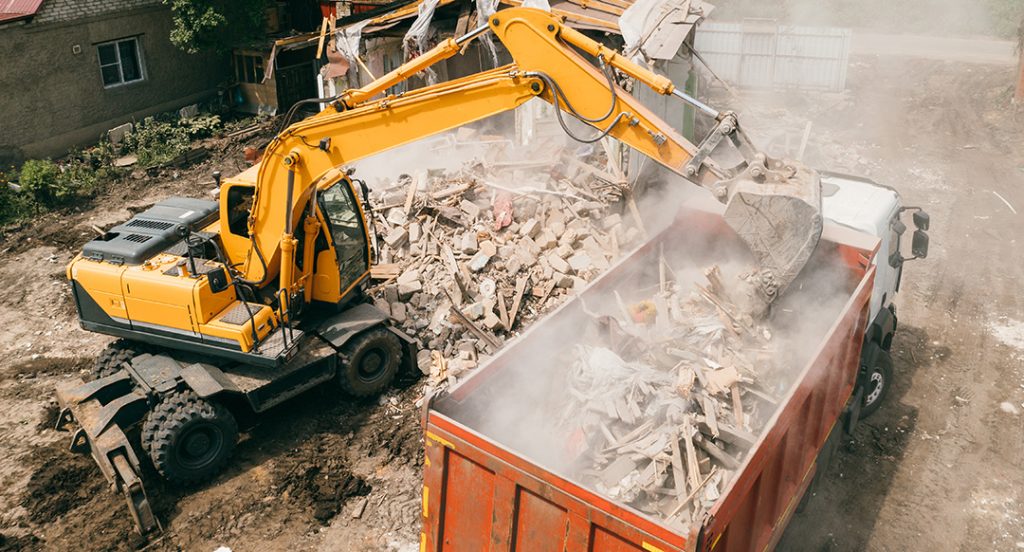A Responsible construction waste management is an important part of sustainable building and construction. It involves the proper disposal of materials that are no longer needed or used during the construction process by eliminating waste where possible; minimizing the amount of waste going to landfills and reusing materials which might otherwise become waste.
What are the main sources of construction waste?
Construction waste is any material that is generated as a result of a construction project. The main sources of construction waste include materials such as concrete, wood, metal, and brick; packaging materials, such as cardboard and plastic; and construction materials, such as gypsum boards, insulation, and roofing materials. In addition, construction waste can also include hazardous materials, such as asbestos, lead, and paint. It is important to properly dispose of construction-produced waste in order to protect the environment and reduce the amount of waste that is sent to landfills.
What are the most effective techniques for managing construction waste?
Construction waste can be a major problem, but there are several effective techniques for managing it. The first step in effective construction waste management is to identify the sources of waste and develop a plan to reduce them. This plan should include strategies for sorting, storing, and disposing of waste materials correctly. This will help to keep the construction site clean, organized and reduce the risk of hazardous materials being mishandled. Implementing a construction waste management plan can help reduce the environmental impact of construction projects, as well as save money by reducing the amount of waste that needs to be disposed of and maximize efficiency on site.
One of the most important steps is to reduce the amount of waste generated in the first place. This can be done by using materials that are more efficient and have less waste, such as prefabricated components. Additionally, you can use materials that can be reused or recycled, such as wood, metal, and plastic. Minimizing the amount of packaging materials used can also help as depicted in the picture below from one of our building projects whereby construction aggregate was packaged in buckets that could be returned to the manufacturer as opposed to packaging bags.
Another effective technique is to separate the waste into different categories. This will help you to identify which materials can be recycled or reused, and which should be disposed of. Additionally, it is important to have a plan for disposing of the waste in an environmentally friendly way. This could include using a waste management company that specializes in construction waste, or donating materials to local charities or organizations.
Finally, it is important to educate your staff and contractors about the importance of managing construction waste. This could include providing training on how to reduce waste, as well as providing incentives for those who are successful in doing so. By implementing these techniques, you can help to reduce the amount of construction waste and ensure that it is managed in an environmentally responsible way.
How can construction waste be recycled or reused?
Construction waste can be recycled or reused in a variety of ways. For example, scrap metal, wood, and gypsum can be recycled at a local recycling center. Additionally, broken concrete and asphalt can be crushed and reused as aggregate for new construction projects. Other materials such as glass, plastic, and cardboard can also be recycled. Finally, many construction materials can be reused on-site, such as bricks, tiles, and lumber.
What are the legal requirements for disposing of construction waste?
Adhering to all local, county and state regulations is important when it comes to construction waste management. This includes ensuring that hazardous waste materials are disposed of properly and that all materials are disposed of in accordance with the regulations. Additionally, it is important to keep accurate records of all waste disposal activities to ensure compliance.
Disposing of construction waste is subject to a variety of legal requirements, depending on the type of waste and the jurisdiction in which it is being disposed. In Kenya, the legal requirements for disposing of construction waste are outlined in the Environmental Management and Coordination Act (EMCA). This act requires that all construction waste be sorted and separated into different categories, such as metals, plastics, wood, and hazardous materials. Additionally, EMCA requires that construction waste be taken to a designated landfill. A permit may also be required to transport the waste, and the disposal of the waste must be compliant with local environmental regulations. It is important to check with local authorities to ensure that all legal requirements are met when disposing of construction waste in Kenya.
By following the tips and strategies outlined in this guide, construction projects can be completed with minimal waste and maximum efficiency. By recycling and reusing materials, construction companies can reduce their environmental impact, save business money, and ensure compliance with all legal requirements. Additionally, proper waste management can help to ensure the safety of workers and the surrounding environment. With the right strategies in place, construction waste management can be made easier and more efficient.
A Responsible construction waste management is an important part of sustainable building and construction. It involves the proper disposal of materials that are no longer needed or used during the construction process by eliminating waste where possible; minimizing the amount of waste going to landfills and reusing materials which might otherwise become waste.
What are the main sources of construction waste?
Construction waste is any material that is generated as a result of a construction project. The main sources of construction waste include materials such as concrete, wood, metal, and brick; packaging materials, such as cardboard and plastic; and construction materials, such as gypsum boards, insulation, and roofing materials. In addition, construction waste can also include hazardous materials, such as asbestos, lead, and paint. It is important to properly dispose of construction produced waste in order to protect the environment and reduce the amount of waste that is sent to landfills.
What are the most effective techniques for managing construction waste?
Construction waste can be a major problem, but there are several effective techniques for managing it. The first step in effective construction waste management is to identify the sources of waste and develop a plan to reduce them. This plan should include strategies for sorting, storing, and disposing of waste materials correctly. This will help to keep the construction site clean, organized and reduce the risk of hazardous materials being mishandled. Implementing a construction waste management plan can help reduce the environmental impact of construction projects, as well as save money by reducing the amount of waste that needs to be disposed of and maximize efficiency on site.
One of the most important steps is to reduce the amount of waste generated in the first place. This can be done by using materials that are more efficient and have less waste, such as prefabricated components. Additionally, you can use materials that can be reused or recycled, such as wood, metal, and plastic. Minimizing the amount of packaging materials used can also help as depicted in the picture below from one of our building projects whereby construction aggregate was packaged in buckets that could be returned to the manufacturer as opposed to packaging bags.
Another effective technique is to separate the waste into different categories. This will help you to identify which materials can be recycled or reused, and which should be disposed of. Additionally, it is important to have a plan for disposing of the waste in an environmentally friendly way. This could include using a waste management company that specializes in construction waste, or donating materials to local charities or organizations.
Finally, it is important to educate your staff and contractors about the importance of managing construction waste. This could include providing training on how to reduce waste, as well as providing incentives for those who are successful in doing so. By implementing these techniques, you can help to reduce the amount of construction waste and ensure that it is managed in an environmentally responsible way.
How can construction waste be recycled or reused?
Construction waste can be recycled or reused in a variety of ways. For example, scrap metal, wood, and gypsum can be recycled at a local recycling center. Additionally, broken concrete and asphalt can be crushed and reused as aggregate for new construction projects. Other materials such as glass, plastic, and cardboard can also be recycled. Finally, many construction materials can be reused on-site, such as bricks, tiles, and lumber.
What are the legal requirements for disposing of construction waste?
Adhering to all local, county and state regulations is important when it comes to construction waste management. This includes ensuring that hazardous waste materials are disposed of properly and that all materials are disposed of in accordance with the regulations. Additionally, it is important to keep accurate records of all waste disposal activities to ensure compliance.
Disposing of construction waste is subject to a variety of legal requirements, depending on the type of waste and the jurisdiction in which it is being disposed. In Kenya, the legal requirements for disposing of construction waste are outlined in the Environmental Management and Coordination Act (EMCA). This act requires that all construction waste be sorted and separated into different categories, such as metals, plastics, wood, and hazardous materials. Additionally, EMCA requires that construction waste be taken to a designated landfill. A permit may also be required to transport the waste, and the disposal of the waste must be compliant with local environmental regulations. It is important to check with local authorities to ensure that all legal requirements are met when disposing of construction waste in Kenya.
By following the tips and strategies outlined in this guide, construction projects can be completed with minimal waste and maximum efficiency. By recycling and reusing materials, construction companies can reduce their environmental impact, save business money, and ensure compliance with all legal requirements. Additionally, proper waste management can help to ensure the safety of workers and the surrounding environment. With the right strategies in place, construction waste management can be made easier and more efficient.



